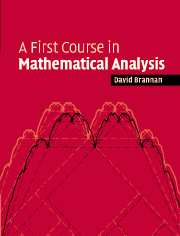Book contents
- Frontmatter
- Contents
- Preface
- 1 Numbers
- 2 Sequences
- 3 Series
- 4 Continuity
- 5 Limits and continuity
- 6 Differentiation
- 7 Integration
- 8 Power series
- Appendix 1 Sets, functions and proofs
- Appendix 2 Standard derivatives and primitives
- Appendix 3 The first 1000 decimal places of √2, e and π
- Appendix 4 Solutions to the problems
- Index
6 - Differentiation
Published online by Cambridge University Press: 05 September 2012
- Frontmatter
- Contents
- Preface
- 1 Numbers
- 2 Sequences
- 3 Series
- 4 Continuity
- 5 Limits and continuity
- 6 Differentiation
- 7 Integration
- 8 Power series
- Appendix 1 Sets, functions and proofs
- Appendix 2 Standard derivatives and primitives
- Appendix 3 The first 1000 decimal places of √2, e and π
- Appendix 4 Solutions to the problems
- Index
Summary
The family of all functions is so large that there is really no possibility of finding many interesting properties that they all possess. In the last two chapters we concentrated our attention on the class of all continuous functions, and we found that continuous functions share some important properties – for example, they satisfy the Intermediate Value Theorem, the Extreme Values Theorem and the Boundedness Theorem. However, many of the most interesting and powerful properties of functions are obtained only when we further restrict our attention to the class of all differentiable functions.
You will have already met the idea of differentiating a given function f; that is, finding the slope of the tangent to the graph y = f(x) at those points of the graph where a tangent exists. The slope of the tangent at the point (c, f(c)) is called the derivative of f at c, and is written as f′(c). But when does a function have a derivative? Geometrically, the answer is: whenever the slope of the chord through the point (c, f(c)) and an arbitrary point (x, f(x)) of the graph approaches a limit as x → c. In this chapter we investigate which functions are differentiable, and we discuss some of the important properties that all differentiable functions possess.
In Section 6.1 we give a strategy for determining whether a given function f is differentiable at a given point c.
- Type
- Chapter
- Information
- A First Course in Mathematical Analysis , pp. 205 - 254Publisher: Cambridge University PressPrint publication year: 2006

